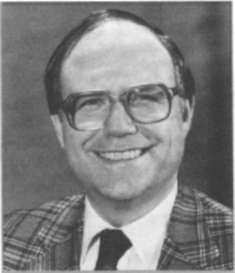 |
Home | Search | Browse | About IPO | Staff | Links |
 |
Home | Search | Browse | About IPO | Staff | Links |
|
Politics Threat to Democratic control of legislature  By CHARLES N. WHEELER III Amid fanfare fit for a matinee idol, former Cook County Democratic Chairman Edward R. Vrdolyak became a Republican a few weeks ago, ending months of suspense about his future but setting off new speculation about the impact of his move. Would the switch by Mayor Washington's old City Council nemesis trigger an exodus to the GOP by other Democratic notables disenchanted with the party's new boss? Could it portend party realignment so dramatic that it might even jeopardize the Democratic majorities in the Illinois General Assembly? As the legislature's fall veto session got underway, the immediate aftershock of Vrdolyak's defection was limited to Rep. Sam Panayotovich (35-Chicago), an affable saloon keeper who followed his 10th Ward mentor into the Republican party. Pragmatism, not philosophy, motivated Panayotovich. Vrdolyak, a possible GOP contender for county office next year, is expected to take his precinct captains with him. That would make Panayotovich a sitting duck in the March primary for a Democratic challenger from the party's anti-Vrdolyak wing. He'll have better odds as a Republican in November. While the spotlight was on Vrdolyak, however, another news item posing a far greater threat to Democratic legislative control went virtually unnoticed. That danger came in the form of U.S. Census Bureau report P-26, No. 86-A, titled "Local Population Estimates," the provisional estimates of the population of Illinois counties as of July 1, 1986. The document revealed that the fastest growing area of Illinois is the Chicago suburbs, which have added nearly a quarter million residents since the 1980 federal census, almost three-quarters of them in the collar counties of DuPage, Kane, Lake, McHenry and Will. Given the one-man, one-vote principle under which legislative district maps are drawn and the proclivity of most suburbanites to vote Republican, it's easy to see why the report is not good news for Democrats. In fact, the work of the government demographers suggests that the suburbs may be the only region of the state that is thriving. Of Illinois' 102 counties, only 26 showed higher '86 estimates than the '80 count, and 20 of those were modest gains of less than 5 percent. Only five counties did better than 6 percent, and four of them were collar counties. The fifth, Johnson County, owed its 13.2 percent population growth mostly to an influx of prison inmates. Heading the list of suburban growth areas was DuPage County, one of the strongest Republican enclaves in the nation, which gained almost 69,000 residents for an estimated 1986 population of about 730,000. Elsewhere in suburbia, the Census Bureau estimated: • Lake County, 480,200 residents, a gain of some 40,000 since the 1980 census. • Kane County, 305,800 residents, a gain of about 27,400 since 1980. • McHenry County, 162,400 residents, a gain of almost 14,700 since 1980. • Will County, 338,400 residents, a gain of nearly 14,000 since 1980. Cook County, meanwhile, grew less than 1 percent, adding an estimated 44,300. The federal report does not include a separate estimate for Chicago, but state planners peg its 1986 population at a tad below three million, or a drop of about 13,000 from 1980. Thus, the suburban Cook County population increased by about 58,000. While the suburban region, including Cook County outside Chicago, grew by an estimated 223,000-plus, the other 96 counties registered a net loss of more than 75,000 residents, with the population decline generally tracking the areas hardest hit by factory closings and other economic hardship. 4/November 1987/Illinois Issues The report estimated the total state population at just under 11.6 million, a modest increase of some 134,000 souls, or about 1.1 percent, from the 1980 count. For redistriciting purposes, that would translate to House districts of about 98,000 people and Senate districts twice that size. Applying those guidelines to the '86 population estimates, the suburbs would be entitled to 22 Senate and 44 House districts, compared to the 18 Senate and 37 House districts now regarded as "suburban." The big loser would be Chicago, whose current dominance in 19 Senate and 37 House districts would be pared to 15 and 31. Downstate Illinois would only lose one of its 44 House seats and retain its 22 Senate districts. Of course, in the last two remaps, Democrats succeeded in protecting city legislative seats by overlapping districts on the city's perimeter into suburban areas to pick up enough additional people to meet population standards. But that technique has its limits. At some point, for example, a hybrid's GOP-leaning suburban portion becomes so large that Democratic map-makers can no longer be sure their city supporters can control an election. Indeed, only three Chicago Republicans have been elected to the Senate since the hybrid technique was introduced in 1971, and all won in split city-suburban districts. And while Democrats in the House now have a comfortable edge, even minus Panayotovich, it's a different story in the Senate. Given the current alignment, shifting even two seats from the city to the suburbs would give Republicans control of the upper chamber. Besides its partisan impact, the report has major governmental implications. The numbers suggest that, for the first time in history, suburbanites outnumber either downstaters or Chicagoans. If suburbia's population boom is translated into legislate power in the 1991 remap, consider the effect on issues like a regional airport authority to deal with air and noise pollution from O'Hare International Airport, or the state school aid formula, under which one instate school district will get more general aid this year than all the public schools in DuPage County combined. Ultimately, the population shifts disclosed by the census report are likely to prove much more significant to the shape of Illinois politics than Vrdolyak's fancy footwork. November 1987/Illinois Issues/5 |
|
|